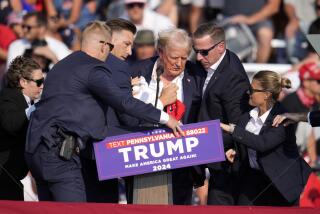Secret Service cites 91 gate-crashers since 1980
- Share via
Washington — Long before a pair of gate-crashers penetrated a White House state dinner, the Secret Service had detailed for its internal use a lengthy list of security breaches dating to the Carter administration -- including significant failures in the agency’s protection of the president.
A summary of a secret 2003 report obtained by the Washington Post, along with descriptions of more recent incidents by federal Homeland Security officials, places Tareq and Michaele Salahi squarely in a rogues’ gallery of autograph hounds, publicity seekers, unstable personalities and others identified by the Secret Service as defeating its checkpoints at least 91 times since 1980.
The document, the most complete accounting of recent Secret Service security breakdowns, includes officers mistakenly admitting to the White House grounds a family in a minivan, a man believed to be a delivery driver and a woman previously known to agents after she had falsely claimed a “special relationship” with President Clinton.
The only assailant to injure a president in the last three decades was John Hinckley, who shot and wounded President Reagan in 1981 from outside the security perimeter established by the Secret Service.
Nevertheless, the list of security breaches exposes significant gaps that could be exploited by would-be assassins, the document states, and erode “one of the best tools for deterring future attempts” -- the aura of invulnerability around the White House.
A Secret Service official confirmed the authenticity of the unclassified document, which was a 39-slide presentation, and said it had been used to train agents and officers in an effort to improve agency operations.
“This document reflects a proactive attempt to evaluate our security and obviously raises the awareness of uniformed division officers and agents about their jobs,” spokesman Edwin Donovan said. “We have to be concerned about the threats to our protectees at all times, whether at the White House or away from the White House.”
The agency is entering what it calls a sustained period of elevated “international, domestic and individual” threats, protecting President Obama, the country’s first African American president, and its two most recent wartime leaders, President George W. Bush and former Vice President Dick Cheney.
After the Salahis’ appearance at last month’s state dinner, the Secret Service launched a criminal investigation into the couple and a sweeping internal review of security procedures. Offering a rare public apology for the incident, the agency’s director, Mark Sullivan, characterized it as a “pure and simple . . . case of human error,” in which three uniformed officers let the well-dressed Salahis pass through gates on a rainy night without confirming their names on a guest list.
The historical list of perimeter breaches indicates that intruders, including the Salahis, have reached the president or another person under Secret Service protection eight times since 1980.
The review was commissioned in 2001 by then-Director Brian Stafford after the service was humiliated for a third time by the most notorious presidential gate-crasher, Richard Weaver, who evaded inauguration security to shake George W. Bush’s hand.
Weaver, a California minister, had previously infiltrated a 1991 prayer breakfast attended by then-President George H.W. Bush, and Clinton’s 1997 inaugural luncheon. He approached the younger Bush again at a prayer breakfast in 2003 before being arrested.
“I believe God makes me invisible to the security, undetectable,” Weaver said.
The Secret Service concluded that Weaver succeeded by manipulating others to obtain tickets, telling guards he was lost or looking for a restroom, and generally “appearing as [if] you are supposed to be there,” as the Salahis apparently did.
More to Read
Sign up for Essential California
The most important California stories and recommendations in your inbox every morning.
You may occasionally receive promotional content from the Los Angeles Times.










